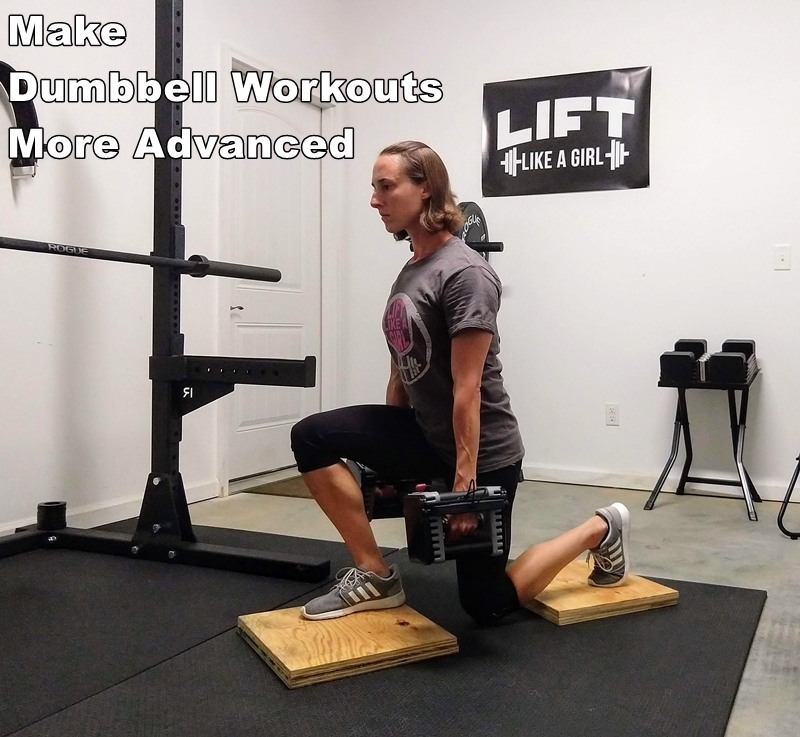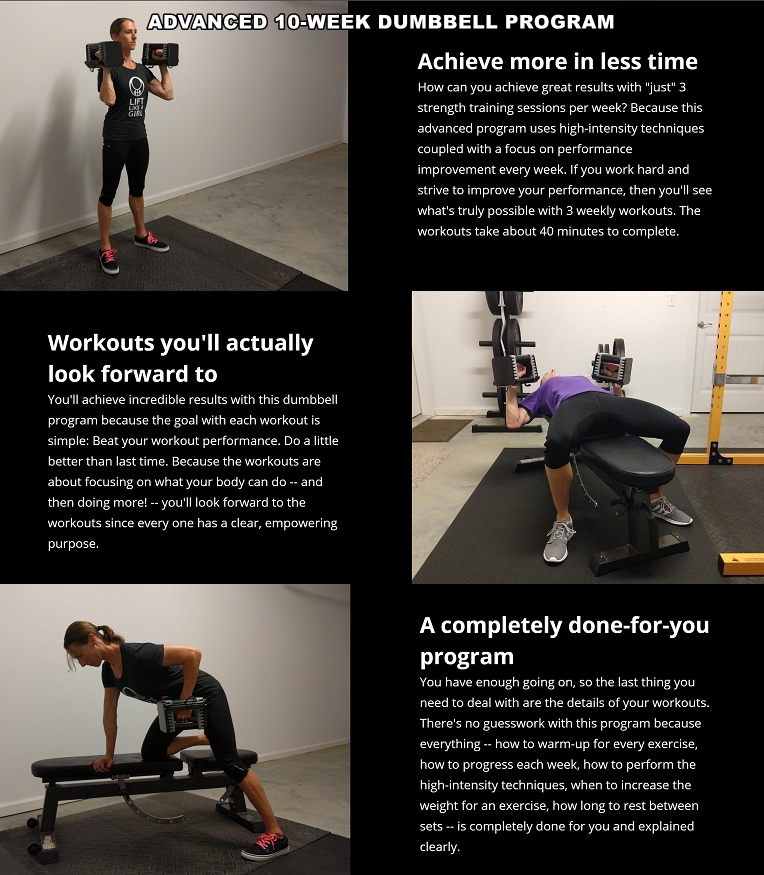
You can listen to this article: Use the player below, download the MP3, or use iTunes.
Perhaps now more than ever, more people are working out at home instead of a gym. And many of these individuals have a few pairs of dumbbells, or an adjustable dumbbell set, at their disposal.
While this allows them to have productive workouts, an inevitable question arises, especially for advanced trainees: Can you still have great workouts with just a few pairs of dumbbells or an adjustable dumbbell set, since weight selections are limited?
Yes. Absolutely, yes.
To get the greatest results from at-home dumbbell workouts, however, you’ll need to get a bit creative. This is especially true if you only have a few pairs of dumbbells to work with.
Apply these nine tips to your at-home dumbbell workouts and keep making awesome progress, even if you’re an advanced trainee.
1) Increase the Weight When Possible
This one is obvious, I know. But if you can progress from bench pressing 35-pound dumbbells for 10 reps to 40-pound dumbbells for 10 reps at the same relative intensity, you’ll be stronger. Likewise, if you increase your split squats from 12 reps with a 20-pound dumbbell in each hand to 12 reps with 25-pound dumbbells, you’ll be stronger.
Increasing the weight is an obvious choice for improving performance, but what should you do when you don’t have any heavier ‘bells to move up to, the weight increase is too much, or just too awkward for the exercise?
2) Improve Your Performance in Various Rep Ranges
Most people train in the 8-15 rep range. Some people may like sets of 3-6, and some may even go up to 20 reps with certain exercises. But when dumbbells are all you have to work with, you should improve your performance in higher rep ranges too. Try sets of 15-20 reps, 20-30, and even up to 50 reps with lower-body exercises like goblet squats.
If you primarily train in the more common 8-15 rep range, play with some higher rep ranges and get stronger in them. You’ll quickly see how effective they can be.
When cranking out high-rep sets, know you must push very close to failure for them to be the most effective, because it’s not until the end of these sets that the majority of muscle fibers get involved. In other words, the last several reps should be difficult, and you should stop the set when you can’t do another rep, or maybe just 1-2, but no more.
3) Use New Exercises
Don’t have heavy enough dumbbells to make Romanian deadlifts and squats challenging enough? Or perhaps loading such movements adequately is too awkward. Start including more single-leg exercises in your workouts.
If your legs are already quite strong and you can perform barbell squats with your bodyweight, and then some, goblet squats can only be so effective for you before they become too awkward to load, unless you keep the reps high. You’ll need to use more single-leg exercises like lunges, split squats, single-leg Romanian deadlifts, and their many variations. You can progressively load these more easily with dumbbells than you can their bilateral counterparts.
4) Take Advantage of High-Intensity Techniques
A major challenge with being a late-intermediate to advanced trainee and only having dumbbells to work with: Adequately loading many exercises will be too awkward (like goblet squats, double-dumbbell squats) or you simply won’t have heavier ‘bells at your disposal. This is when high-intensity techniques are beneficial. (If you’re a strength training beginner, don’t use these techniques yet because they won’t be nearly as effective. You need to get stronger and build a solid foundation first.)
There are several you can use, but I have a few favorite techniques that are particularly beneficial with dumbbell exercises.
4a) Rest/pause
This technique has been popularized by the DC training crowd (Dante Trudel, owner of True Nutrition, in particular, and Dusty Hanshaw), and one I first tried in my early 20s, and absolutely loved how tough it was. With dumbbell exercises I prefer to keep the reps a bit higher, for safety, when using the rest/pause method. For example with a dumbbell shoulder press, begin by performing a set of 12-20 all-out reps — the point when another rep isn’t possible — then set the ‘bells down and rest for 25-30 seconds. Then crank out as many reps as you can again. Rest 30 seconds one last time, then crank out as many reps as possible.
The total of those three “sets” is a single rest/pause set. For example, someone may use 30-pound dumbbells and get 14 reps for the first set, 6 for the second, and 5 for the third. This would be a total of 25 reps. Next time the workout is repeated, the goal is to perform more total reps. Simple, brutal, effective.
4b) Supersets
You’re likely familiar with non-competing supersets (i.e., working different muscle groups), like doing a dumbbell bench press and one-arm dumbbell row in alternating fashion. But supersets can be really useful for hitting the same body part when training with dumbbells. For example, perform an all-out set of alternating reverse lunges for 10-15 reps per leg, and then immediately crank out as many goblet squats as possible with one of the dumbbells.
This is a great way to smoke your legs when you’re limited by the amount of weight you can use.
4c) Drop sets
These can certainly be done with smaller muscle groups like shoulders, biceps and triceps. For example, crank out as many biceps curls as possible with 20-pound dumbbells, then immediately drop down to the 15s and repeat, then drop down to 12s or 10s for one final all-out set.
Drop sets are particularly brutal for rear-foot-elevated split squats. Do not attempt these if you’re not advanced, or have a hefty supply of mental fortitude. (This is used in the advanced 10-week dumbbell training program. Check it out if you’re interested in a done-for-you program that has built-in progressions from week to week.)
5) Manipulate Lifting Tempo
Just because you may be limited by how much weight you can add to an exercise doesn’t mean there aren’t other ways to make the exercise more challenging that don’t involve increased loading.
These are brutally effective. Consider yourself warned.
5a) Slow(er) negatives
Make the eccentric (“negative”) phase of a lift deliberately slower. For example, take three to five seconds to lower down in a squat, or three seconds to lower down on a chin-up or push-up. This will instantly make a weight/variation feel more challenging. If you can, for example, perform 20 push-ups at a regular tempo, you may only get 15 or so with a three-second eccentric on every rep.
5b) Paused reps
Hold the bottom position of a squat for one to two seconds on every rep, for example. You can also hold the bottom position of a push-up, dumbbell bench press, dumbbell shoulder press, lunge, etc. Adding a pause to the bottom of a chin-up or dumbbell row is excellent too.
5c) Constant-tension reps
Crank out the reps of an exercise non-stop, without locking out your joints. With squats and rear-foot-elevated split squats, don’t lock out your knees completely — no stopping at the top — and just keep going until your legs are jello. With push-ups, don’t pause at the top of the movement to catch your breath toward the end of a set. Keep the reps smooth and controlled, but crank them out without pausing at any point.
Bonus tip: Manipulating lifting tempo using the methods above is an excellent way to modify training programs for lifters who have achy joints or tend to feel “beat up” from lifting too heavy, because the load is naturally limited with those techniques.
Incorporate those nine training methods into your dumbbell-only workouts, and take your workouts to a more advanced level.
If you want a done-for-you program on an easy-to-use app that uses the methods described above, then check out the new advanced dumbbell program.
2021 New Year Sale on Dumbbell Workout Programs

This week only you can get the new advanced dumbbell workout program for 25% off. Use the code “ADVANCED25” at checkout.
Not an advanced lifter but still want a done-for-you dumbbell program? Check out the beginner-intermediate dumbbell program. You can get it for 25% off this week only. Use the code “BEGINNER25” at checkout.
The post 9 Ways to Make Dumbbell Workouts More Advanced appeared first on Nia Shanks.
9 Ways to Make Dumbbell Workouts More Advanced posted first on niashanks.com
No comments:
Post a Comment